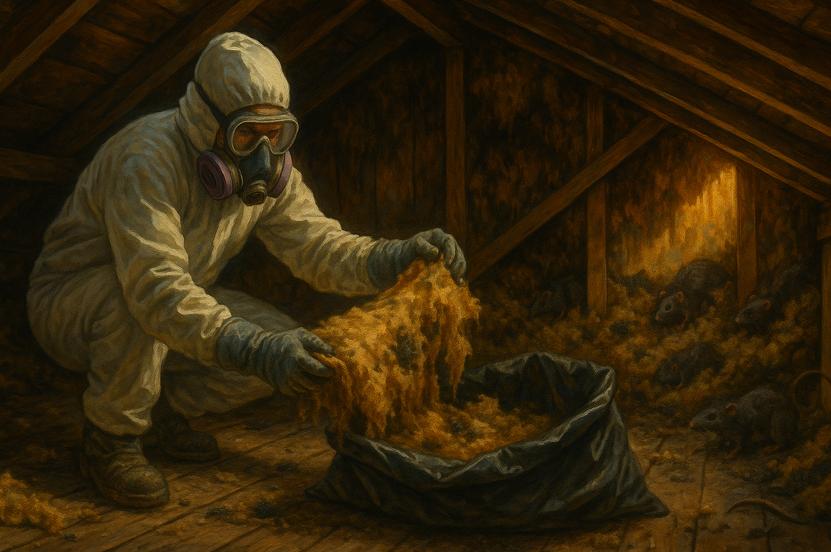When Insulation Turns Gross
Insulation doesn’t last forever. Over time, the material can break down, soak up moisture, or become a cozy nest for things that squeak. Older fiberglass tends to compress and decay, cellulose can become a sponge for humidity, and both can become mold-friendly if there’s even mild condensation.Mold, especially black mold (Stachybotrys chartarum), thrives in damp, poorly ventilated attic spaces. Add organic dust and dead insects into the mix, and you’ve got a fungal Airbnb up there. Mold spores can travel through HVAC systems and end up triggering allergies, asthma, or worse.
Rodents leave behind more than just noise in the walls. Their feces and urine dry into airborne particles, which can carry viruses like hantavirus or bacteria such as leptospirosis. Not the legacy any attic should aim for.
Then there’s the insulation itself. In homes built before the 1990s, you might even find materials containing asbestos or formaldehyde-laced fiberglass. These aren’t just outdated—they’re medically bad ideas wrapped in dusty fiberglass sleeves.
Red Flags You Can Spot Without Crawling Through the Rafters
You don’t need a hazmat suit to do a quick attic check. Here’s what to look for:- Brown or black blotches on insulation or roof sheathing (potential mold)
- A musky or “earthy” smell that never quite goes away
- Chewed insulation or droppings in corners—classic rodent graffiti
- Discolored, compressed, or shredded insulation
- Visible dust plumes when you disturb the material (not good)
What Proper Removal Actually Looks Like
Removing contaminated attic insulation is not the same as sweeping the garage. If you’ve got mold, feces, or questionable fibers involved, you need more than enthusiasm and a dust mask. Here’s how it’s done right:- PPE matters. That means full-body disposable suits, N95 or P100 respirators, gloves, and goggles. No exceptions.
- Containment setup. Professionals isolate the attic space using plastic sheeting and negative air machines to prevent contaminated particles from spreading to the rest of your home.
- HEPA vacuuming before removal. Yes, they vacuum the insulation—this reduces airborne contaminants during removal.
- Bagging and sealing. Old insulation is bagged in heavy-duty contractor bags and sealed before transport. This is not a time for flimsiness.
Decontaminate Before You Re-Insulate
Once the insulation’s out, you’re not done. The attic needs to be thoroughly cleaned and sanitized. This isn’t optional, especially if rodents or mold were involved.Enzyme cleaners and disinfectants designed for biohazards can neutralize urine proteins, fecal residue, and mold colonies. Some professionals even fog the attic with antimicrobial solutions to reach into crevices that brushes and vacuums miss.
Only after this deep cleaning should new insulation be installed. Replacing it too early can trap lingering spores or moisture, and you’ll just be re-insulating the problem.
Choose Your Next Insulation Wisely
Now that the attic is clean, sealed, and blessedly free of rodent waste, it’s time to install new insulation. But what type?- Blown-in cellulose is eco-friendly and affordable, but not ideal if your attic tends to run humid—it absorbs moisture and can support mold if wet.
- Fiberglass batts are cheap and easy to install but leave gaps around irregular framing, and they don’t air-seal anything.
- Spray foam (especially closed-cell) offers top-notch air sealing and moisture resistance, and it doesn’t settle or degrade. It’s expensive—but worth considering if you want a long-term fix.
A Word on DIY
You may be tempted to tackle attic insulation removal yourself, especially if you enjoy suffering. But if you even suspect mold, rodents, or anything asbestos-adjacent, call a pro. DIY removal without proper PPE or containment can expose you and your household to real harm.That said, if your attic is simply dusty and underinsulated, and you’re certain there’s no mold, pests, or unknown fuzzy horrors, a DIY job may be feasible. Just still suit up—eye protection, gloves, a good respirator—and take breaks before you hallucinate from the heat.
Not Just Dust in the Wind
Attic insulation removal isn’t glamorous. You won’t win any design awards or Instagram likes for vacuuming rat urine and yanking out 30-year-old fiberglass. But it might be one of the most important things you do for your home’s health—and yours.Indoor air quality is directly linked to the state of your attic. Spores, particulates, and contaminated dust don’t stay politely in the ceiling. They circulate, they settle, and they’re inhaled. If you’ve been waking up stuffy, if the house smells odd, if energy bills are climbing for no clear reason—your attic may be overdue for a full clean-out.
And once it’s done, you’ll never look at ceiling air vents the same way again. They won’t feel like suspicious holes into mystery zones. They’ll be trusted passageways of clean, breathable air. Or at least, less sketchy ones.
Goodbye Mold, Hello Sanity
Removing old attic insulation isn’t just about making a space cleaner—it’s about making it safer. It’s about knowing your house isn’t circulating the ghost of raccoons past or the slow rot of damp cellulose. You deserve better air. Your lungs deserve less drama. And your attic deserves to retire its biohazard side hustle.So if your insulation is starting to look more like mulch than material—or if the attic gives off the same vibe as an abandoned sauna—it might be time to bring in the gloves, the masks, and the pros.
The payoff? A cleaner home. A quieter one. And maybe—just maybe—the first deep breath in a while that doesn’t make your sinuses feel like they’ve been punched by history.
Article kindly provided by Insulation Commandos


